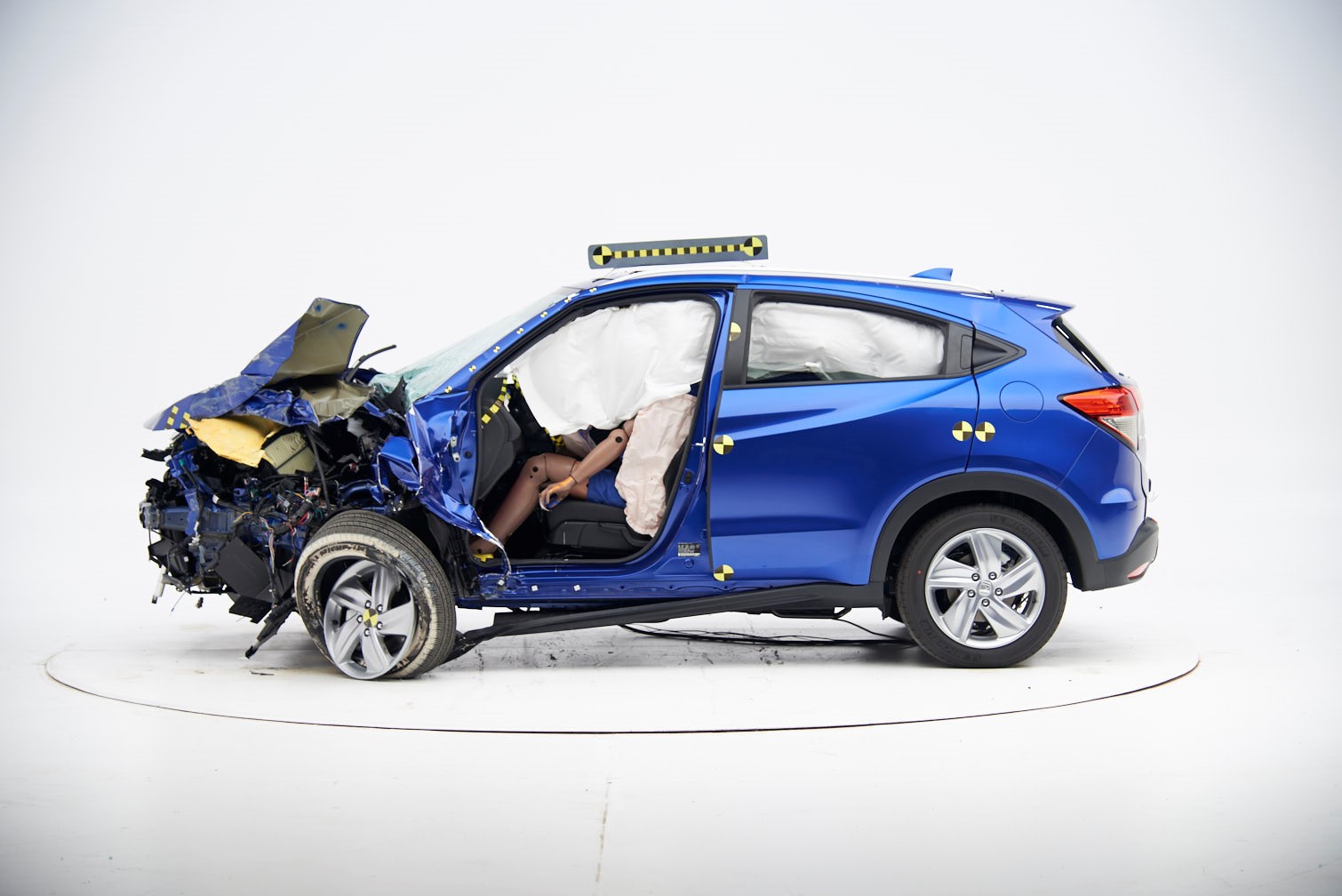News
Honda “Crashes” New York International Auto Show with 2019 Honda HR-V

- Honda is showcasing its achievement in safety performance, including the display of a HR-V crash tested by the Insurance Institute for Highway Safety (IIHS)
- Honda highlights its commitment to safety rating leadership at all price points
- 2019 HR-V is one of seven Honda models to earn an IIHS TOP SAFETY PICK rating when equipped with Honda Sensing® technology and certain headlights
- HR-V earns top "Good" rating in all six IIHS crashworthiness tests and a 5-Star Overall Vehicle Score from NHTSA
The New York International Auto Show draws more than 1 million consumers each year to see the hundreds of bright, shiny vehicles. For the first time at an auto show, Honda will display a refreshed 2019 HR-V that recently was safety crash tested by the Insurance Institute for Highway Safety (IIHS). The emotional display of the HR-V showcases what a vehicle endures in a crash (and what it looks like after), including the structural strength and airbag deployment, highlighting the progression of safety technology. The HR-V exhibits safety rating leadership at an affordable price, starting at $20,520.
"Safety performance is an important factor in the purchase decision of most car buyers regardless of vehicle size or price, and we wanted to display how well our entry SUV, the Honda HR-V, performed in one of the most stringent collision tests in the world," said Henio Arcangeli, Jr., senior vice president of Automobile Sales at American Honda Motor Co., Inc. and general manager of the Honda Division. "By having a crashed HR-V on display at the New York Auto Show, media and consumers will be able to see first-hand how the HR-V performed in the IIHS test, with dramatic, real-world visuals to showcase our safety rating leadership and our commitment to Safety for Everyone."
The affordable 2019 HR-V subcompact crossover, equipped with Honda's proprietary Advanced Compatibility Engineering™ (ACE™) body structure, has earned the highest available rating of "Good" in all six IIHS crashworthiness tests, and has been named an IIHS TOP SAFETY PICK when equipped with Honda Sensing® technology and certain headlights. ACE™ body structure absorbs the violent forces of a crash, reducing the likelihood of injury to vehicle occupants. All 2019 HR-V models achieve "Good" ratings for driver-side small overlap front, passenger-side small overlap front, moderate overlap front, side impact, roof strength, and head restraints and seats, along with a "Superior" rating for front crash prevention when equipped with available Honda Sensing®.
The HR-V on display was safety crash tested in the IIHS driver-side small overlap front test. This test is designed to replicate what happens when the front left corner of a vehicle collides with another vehicle or an object like a tree or utility pole. This crash test is a challenge for some safety belt and airbag designs because occupants move both forward and toward the side of the vehicle. During this test, the HR-V traveled at 40 mph toward a 5-foot-tall rigid barrier.
Honda has seven 2019 model-year vehicles -- Insight, Accord1, HR-V2, CR-V2, Pilot2, Odyssey2 and Ridgeline2 – that earned a TOP SAFETY PICK or TOP SAFETY PICK+ rating from IIHS. Further, all 2019 model-year Honda vehicles that have been fully tested by the National Highway Traffic Safety Administration (NHSTA) have earned a top 5-star Overall Vehicle Score, 11 models in total.
In addition to the ACE™ body structure, and advanced seatbelt and airbag system that are applied to all new Honda vehicles, the Honda Sensing® suite of advanced safety and driver-assistive technologies is now standard or available on all Honda nameplates, and more than 80 percent of 2019 model-year Honda vehicles sold in the U.S. are equipped with these potentially life-saving technologies. Honda Sensing® technology is already in nearly 2 million vehicles on U.S. roads today, and includes Collision Mitigation Braking System™ (CMBS™); Forward Collision Warning; Road Departure Mitigation (RDM) incorporating Lane Departure Warning (LDW); Lane Keeping Assist System (LKAS); and Adaptive Cruise Control (ACC).
The 2019 New York International Auto Show is open to the public April 19 - April 28 at the Jacob K. Javits Convention Center. In addition to the IIHS safety crash tested HR-V, Honda will display its best-selling models like Civic, Accord and CR-V, plus the all-new Passport SUV.
About Honda
Honda offers a full line of reliable, fuel-efficient and fun-to-drive vehicles with advanced safety technologies sold through over 1,000 independent U.S. Honda dealers. The Honda includes the Fit, Civic, Insight, Accord and Clarity series passenger cars, along with the HR-V, CR-V, Passport and Pilot sport utility vehicles, the Ridgeline pickup and the Odyssey minivan.
Honda has been producing automobiles in America for more than 35 years and currently operates 19 major manufacturing facilities in North America. In 2018, more than 90 percent of all Honda brand vehicles sold in the U.S. were made in North America, with nearly two-thirds made in America, using domestic and globally sourced parts.
About Honda Safety Leadership
Honda has a long history of leadership in the development and application of advanced technologies designed to enhance the safety of all road users, including automobile occupants, motorcycle riders and pedestrians. The company operates two of the world's most sophisticated crash test facilities, in Ohio and Japan, and is responsible for numerous pioneering efforts in the areas of crashworthiness, airbag technology, collision compatibility and pedestrian safety.
For More Information
Consumer information is available at automobiles.honda.com. To join the Honda community on Facebook, visit facebook.com/honda. Additional media information including detailed pricing features and high-resolution photography of all 2019 Honda models is available at hondanews.com.
Error: You currently have access to a subset of X API V2 endpoints and limited v1.1 endpoints (e.g. media post, oauth) only. If you need access to this endpoint, you may need a different access level. You can learn more here: https://developer.x.com/en/portal/product